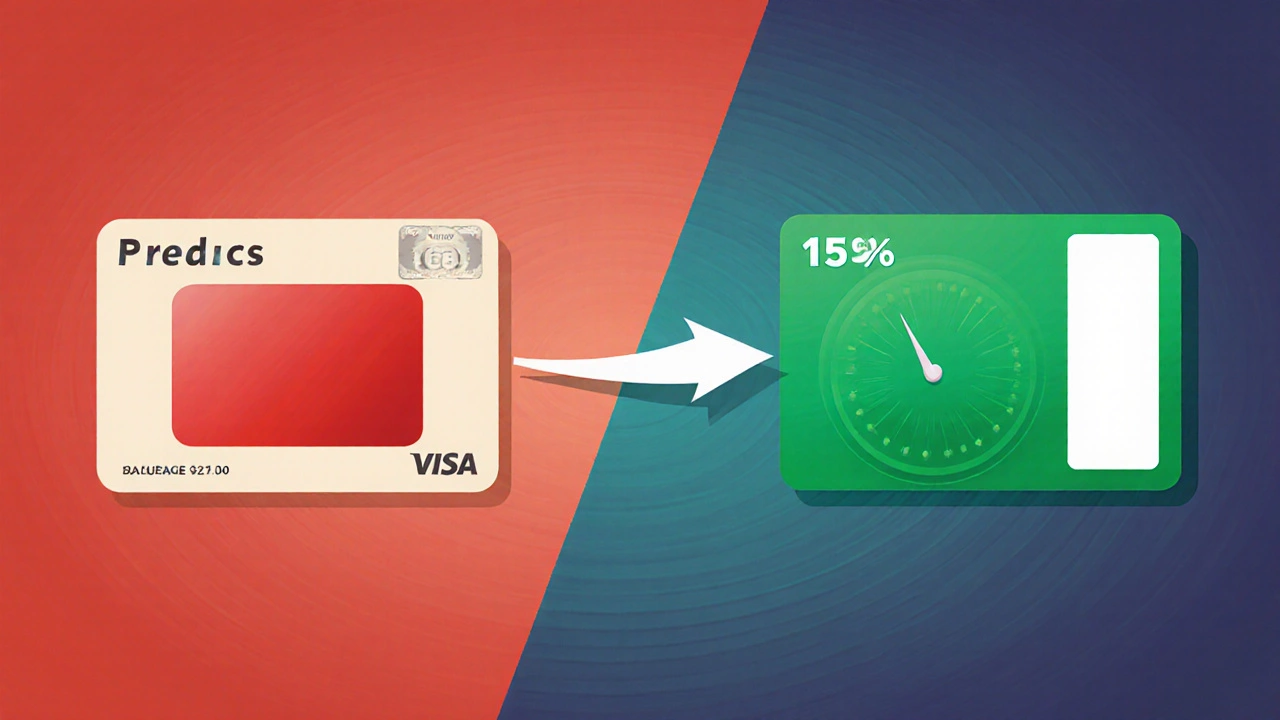Credit Utilization Calculator
Current Credit Situation
Balance Transfer Details
Results
Key Takeaways
- Balance transfers generate a hard inquiry, which can dip your score by a few points.
- Keeping overall credit utilization below 30% - ideally under 10% - mitigates most score damage.
- Length of credit history isn’t reset by a transfer, but closing old accounts can shorten it.
- Strategically timing a transfer (e.g., after a recent score increase) reduces the net effect.
- Follow a simple checklist to protect your score while saving on interest.
What a Balance Transfer Actually Is
When you move an existing balance transfer a process where you shift debt from one credit card to another, usually to take advantage of a lower interest rate, you’re essentially asking a new card issuer to pay off part or all of the debt you owe on another card.
The new issuer then becomes the primary holder of that debt, and you agree to repay it under the new card’s terms. The move can save you hundreds of dollars in interest, but it also involves a few credit‑score‑related steps that many people overlook.
How Credit Scores Are Calculated
Most scoring models, like FICO® and VantageScore®, break a score into five buckets. The three that matter most for balance transfers are:
- Payment History - 35% of the score. Late or missed payments on any card drag the score down.
- Credit Utilization - 30% of the score. This is the ratio of total revolving balances to total credit limits.
- Length of Credit History - 15% of the score. The age of your oldest account and the average age of all accounts matter.
The other two factors - New Credit and Credit Mix - play a smaller role, but they still influence the final number.
Hard Inquiries: The First Score Hit
When you apply for a new credit card to perform a balance transfer, the issuer runs a hard inquiry. This shows up on your credit report and can lower your credit score by 5‑10 points, depending on how many recent inquiries you already have.
Hard inquiries stay on your report for two years, but their impact fades after the first 12 months. A single inquiry isn’t a disaster, but stacking several (e.g., applying for a loan, a new card, and a personal line of credit within a short window) can compound the hit.

What Happens to Your Utilization After a Transfer
Imagine you owe $4,000 on CardA with a $5,000 limit (80% utilization) and you transfer the whole balance to CardB, which has a $10,000 limit. Suddenly your total revolving balance is still $4,000, but your overall available credit jumps to $15,000, lowering utilization to roughly 27%.
That drop is great for your score - as long as you don’t add new purchases that push utilization back up. The key is to keep the transferred balance (plus any new spending) under 30% of the combined limits, preferably under 10% if you’re targeting a score boost.
Length of Credit History and Account Closure
Opening a new card for a balance transfer doesn’t erase the age of your existing accounts. However, if you decide to close the old card after the transfer, you’ll lose the credit line it provided and possibly shorten the average age of your accounts.
Because length of credit history accounts for 15% of your score, it’s generally smarter to keep the original card open, even if you stop using it. Just be sure it’s a “no‑annual‑fee” card, so you aren’t paying extra for a dormant account.
Strategic Timing to Minimize Damage
- Check your current score first. If you’re already in the high‑700s, a hard inquiry might cause a small dip that you can absorb.
- Plan the transfer after a recent score increase. A boost from paying down a large balance can offset the inquiry’s effect.
- Space out applications. If you need a new card for a transfer, wait at least six months after any other recent credit applications.
- Pay the transferred balance quickly. The longer the high balance sits on a new account, the more the utilization factor continues to influence your score.
Real‑World Example
Sarah, 34, had two cards:
- CardX: $3,200 balance, $4,000 limit (80% utilization)
- CardY: $0 balance, $6,000 limit
Her score was 695. She applied for CardZ, a $12,000 limit card offering a 0% intro rate on balance transfers. The hard inquiry dropped her score to 688. After the transfer, her total balances were $3,200, but her total credit limit rose to $22,000, pulling utilization down to 15%.
Within two months, she paid $1,200 of the transferred amount and kept new spending below $500. Her utilization slid to about 9%, and her score rebounded to 710 - higher than before she ever opened CardZ.

Checklist Before You Transfer
- Review your current credit report for existing inquiries and any errors.
- Calculate your current credit utilization. Aim for under 30% after the transfer.
- Choose a card with a low or zero balance‑transfer fee (some charge 3% of the transferred amount).
- Confirm the intro APR period (typically 12‑18months) and note the expiration date.
- Plan how you’ll pay down the balance each month - set up automatic payments if possible.
- Decide whether to keep the old card open; if it has an annual fee, weigh the cost against the credit‑history benefit.
- Avoid opening another new credit line for at least six months after the transfer.
Comparison: Balance Transfer vs New Purchase on a New Card
| Factor | Balance Transfer | New Purchase |
|---|---|---|
| Hard Inquiry | Yes - once when the new card is approved | Yes - same single inquiry |
| Utilization Change | Usually decreases (higher total limit) | Usually increases (new balance adds to existing totals) |
| Credit Age Impact | Neutral if old card stays open | Neutral if old card stays open |
| Potential Score Gain | May rise 5‑15 points if utilization drops | May drop 5‑10 points if utilization rises |
| Cost Consideration | Transfer fee (often 0‑3% of amount) | Standard purchase APR unless you qualify for a promo |
Common Misconceptions
- My score will crash forever. No - the hard inquiry’s effect fades after a year, and a lower utilization can actually boost your score.
- Closing the old card erases the debt. Closing only removes the account from your report; the balance remains and still counts toward utilization.
- All balance‑transfer offers are the same. Fees, intro‑rate length, and post‑promo APR vary widely. Scrutinize the fine print.
Next Steps If You’re Ready to Transfer
1. Gather your current card statements and note the balances.
2. Use an online credit‑score simulator (many banks provide one) to see the projected impact of a new hard inquiry.
3. Apply for the target card, keeping the application concise and accurate.
4. Once approved, initiate the transfer through the new issuer’s portal - most let you transfer up to the full balance in a few clicks.
5. Set a reminder for the intro‑rate expiration and schedule monthly payments that bring the balance down steadily.
Frequently Asked Questions
Will a balance transfer lower my credit score permanently?
No. The hard inquiry from the new card can cause a short‑term dip of 5‑10 points, but the effect fades after about 12 months. If the transfer reduces your overall utilization, your score can rebound and even improve over its pre‑transfer level.
Do I need a perfect credit score to qualify for a balance‑transfer card?
Most balance‑transfer cards accept scores in the mid‑600s and above. Lenders look for a clean payment history and reasonable utilization. A score of 650‑700 usually lands you a decent intro‑rate offer.
Should I close the old card after the transfer?
Only if it has an annual fee that outweighs the credit‑history benefit. Keeping it open preserves your total credit limit and average account age, both of which help your score.
How long does a balance‑transfer fee apply?
The fee - typically 0‑3% of the transferred amount - is a one‑time charge applied when the transfer is processed. It does not recur each month.
Can I transfer a balance more than once?
Yes, but each new transfer usually triggers another hard inquiry and may incur additional fees. Repeated transfers can also signal risk to lenders, potentially hurting future credit‑line approvals.
